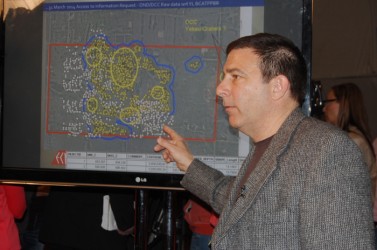Article Origin
Volume
Issue
Year
Nearly a month after the Enoch Cree Nation closed its golf course and historic cultural grounds because of the fear of unexploded munitions, a meeting called by Aboriginal Affairs and Northern Development Canada on May 1 with the band and the Department of National Defence has yielded very little new information – and has brought the band no closer to re-opening Indian Lakes Golf Course and the Ta-Wow Cultural Grounds.
Enoch Cree Chief Ron Morin is both frustrated with the lack of confirmed information and the federal government’s refusal to speak publicly about exactly what happened in the Yekau Lake area, which had been used for bombing practise by at least nine countries during World War II.
“The Department of National Defence absolutely is elusive and does not fully want to tell everything that’s gone on the lands,” said Morin.
The lack of information led Chief and council to hire its own expert last year in order to get a better understanding of the extent and magnitude of the unexploded ordinances in the area. Morin said they had been led to believe by the federal government that the site was used to drop 11.5-16.5 pound smoke bombs. He also said they were told 12,000 munitions were dropped, but council now estimates that number at 140,000 to 200,000.
Morin stressed that the DND never received approval from the Enoch council of the day to use the area between 1941-46 for a Commonwealth practise bombing site. Permission was granted by the Indian agent.
Morin said that Enoch Cree Nation had requested funding from the government to undertake an analysis of the bombing site. The government refused the request but instead in 2008, with permission from the band and unfettered access to the area, undertook its own analysis. While the government released some of its findings to the band, Chief and council are still awaiting the final report.
In response, Enoch Cree Nation hired Anvil GeoSpatial Corporation to determine if the area was safe for public use.
“Our findings to date contradict the information that was made available to us (by the federal government). Based on that …I have to assume (the area) is potentially dangerous unless the government can basically demonstrate otherwise,” said Reg Letourneau, president of Anvil.
Anvil conducted its own research and investigative ground work, but also used information provided by the federal government or garnered through the Access to Information Act.
“Alarming” information came to light, said Letourneau, including two areas that “appeared to be the results of … bomb craters.” Also discovered was an unexploded practise round.
“It’s relatively harmless, but it’s symbolic in terms of what it represents. This is an artillery round. A Nation has been led to believe for almost 70 years that this was a Commonwealth air practise bombing range and no one had ever suggested it was an artillery range,” said Letourneau.
“We are absolutely disgusted and angry… with these findings,” said Morin.
Following the May 1 meeting, Morin said the band had received a commitment from DND that it would contract personnel to examine the area in question, along with Enoch’s findings. DND also said it would try to obtain more information on what happened on the First Nation.
Morin said that the band has requested DND assist in the relocation of the cultural grounds. He added they are not talking about compensation at this point, but are instead pushing for confirmation on what happened on Enoch lands.
“We want to make sure the safety is first and foremost,” he said.
The safety of the rodeo grounds is also been drawn into question as well as cratered-areas north and east of the golf course near residences.
Closure of the Indian Lake Golf Course will impact at least 50 employees and those within the Nation’s cultural department will also be affected.
Speaking in April, Morin said there was also concern that German and Japanese Prisoners of War who were held in camps at the Enoch Cree Nation and died while in care may have been buried on Enoch land. He said preliminary examination has found what could be burial sites or graves not far from the POW camps.
“We need to give proper homage, respect and diplomacy to those nations and do proper ceremony here for any of their loved ones that may have been lost,” said Morin.
- 2937 views

